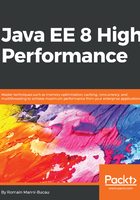
The build
The only dependency Java EE requires is the Java EE API:
<dependency>
<groupId>javax</groupId>
<artifactId>javaee-api</artifactId>
<version>${javaee-api.version}</version> <!-- 8.0 -->
<scope>provided</scope>
</dependency>
Here, the point is to ensure that the API is provided, which means it will not be packaged in the deliverable and will inherit from the server API. The server providing the services associated with the API also provides the API with the right supported version and the right defaults matching the built-in implementations.
Since Java EE 6, there are two main flavors of Java EE: the web profile and the full profile. The web profile is a light version, with only half the specifications compared with the full profile, more or less. The web profile supports only web applications and, therefore, war files. Most of this book will work with a web profile server, so we will package our application as war:
<packaging>war</packaging>
Since we need Java 8, don't forget to configure the Java source and target version in the build. It can be done in different ways, but configuring maven-compiler-plugin as follows is an efficient one:
<plugin>
<groupId>org.apache.maven.plugins</groupId>
<artifactId>maven-compiler-plugin</artifactId>
<version>3.6.1</version>
<configuration>
<source>1.8</source>
<target>1.8</target>
</configuration>
</plugin>